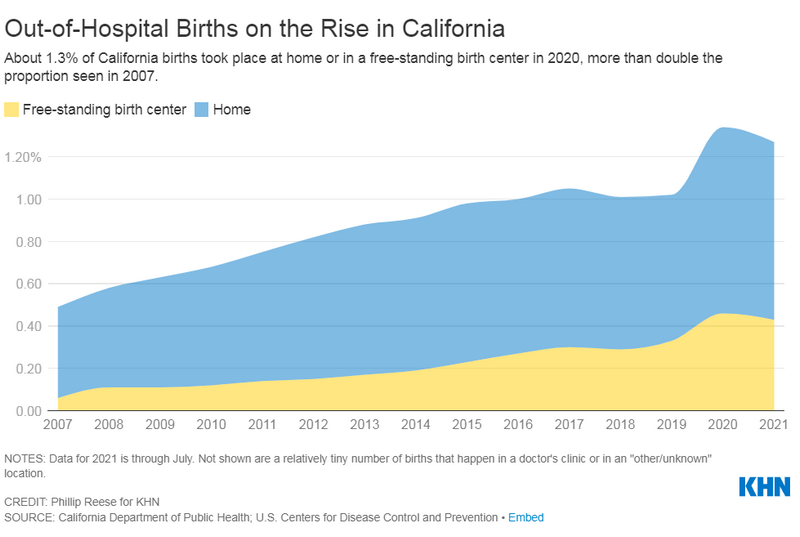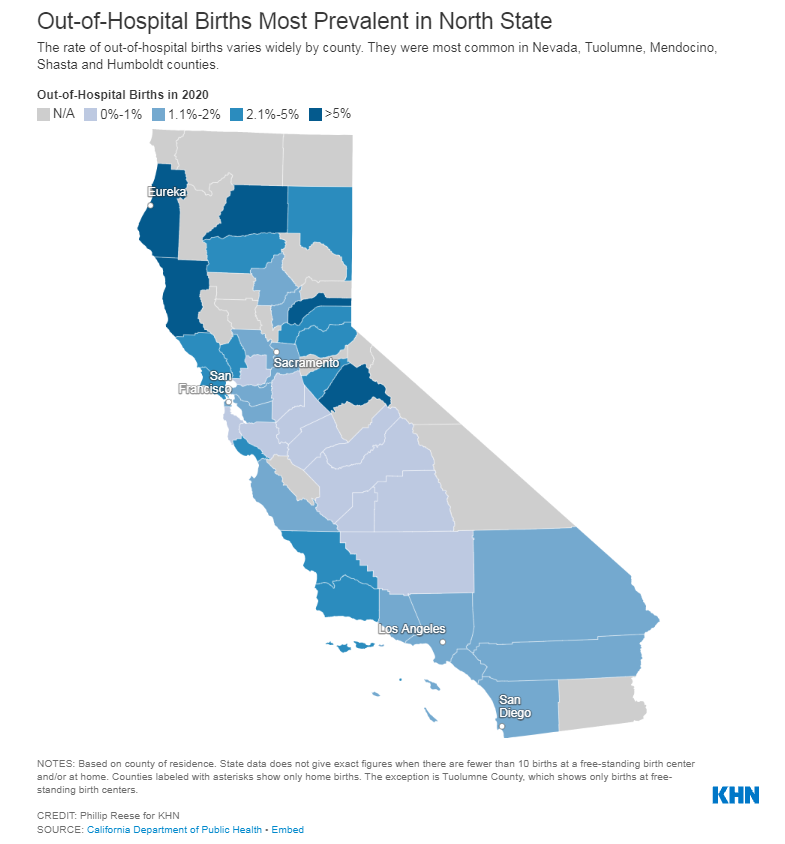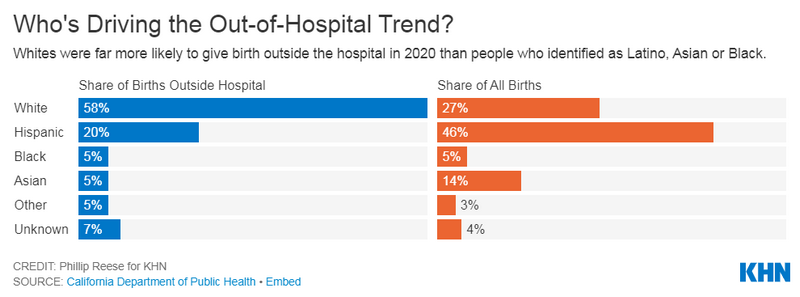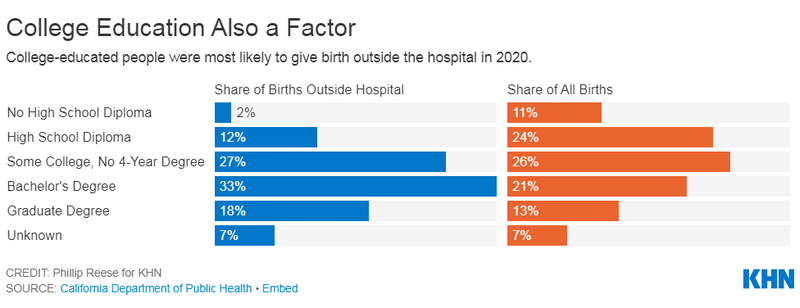
In a back-to-the-future twist on birth trends, California is seeing a sustained rise in the number of women choosing to deliver their babies in settings other than a hospital, a shift that accelerated as the pandemic created more risky and onerous conditions in many hospitals.
About 5,600 people gave birth outside a hospital in California in 2020, up from about 4,600 in 2019 and 3,500 in 2010. The shift took place during a widespread “baby bust,” so the proportion of births outside hospitals rose from 0.68% in 2010 to 1.34% in 2020, according to a KHN analysis of provisional data from the California Department of Public Health. The proportion of births outside hospitals stayed relatively high — 1.28% — from January through July 2021.
From 2009 to 2019, the proportion of births nationwide outside hospitals rose from 1.01% in 2009 to 1.56% in 2019. Nationwide data for 2020 and 2021 is not yet available.
Births away from hospitals usually take place with the help of licensed midwives working at the homes of clients or at free-standing “birth centers.” In either setting, expectant parents typically meet with midwives several times during the pregnancy to get comfortable, express their hopes for the pregnancy and learn about the birthing process.
Intentional at-home births and deliveries at midwife-run birthing centers are typically restricted to “low-risk” pregnancies. Women giving birth in those settings generally do not have serious preexisting health conditions like diabetes or high blood pressure that could complicate their babies’ births; they are giving birth to one child — no twins or triplets; and they are not expected to undergo a breech delivery, in which the baby emerges feet first, said Erina Angelucci, a certified nurse midwife at Best Start Birth Center in San Diego.
Midwives interviewed said they’ve heard from far more women in recent years turning to home births to avoid epidurals, induced labor and other invasive procedures common in hospital delivery rooms.
“I think people are looking to be more empowered in their birth and less ‘just go along with whatever happens,’” said Shari Stone-Ulrich, a certified nurse midwife and midwife services clinical director at Best Start.
Many people want to avoid cesarean sections unless absolutely necessary, several midwives said. About 30% of births in California hospitals last year were via C-section, though that figure has dropped some in recent years, state data shows.
“For first-time moms, C-sections in hospitals are very high,” said Miriam Singer, 32, who gave birth to her son, Eitan, at Best Start a few weeks ago. “So, knowing that the birth center is going to work with you and understand it’s going to be a longer process and just make sure everything’s going well, you really minimize your chances of having a C-section or an emergency situation.”
Singer has three older children, ages 4, 6 and 9. Three of her kids were born in a free-standing birth center and one was born at home.
“Birth is just a very natural part of life, and it should be approached as something that is natural, and we should follow our body and listen to our body going through the process,” she said. “I find the approach maybe in the hospitals a little bit more like it’s an emergency.”
As the coronavirus swept across California, families sought births outside hospitals for other reasons. Some didn’t want to give birth in a setting where they feared contracting covid-19. Others bristled at rules restricting when partners and family members could be present during labor.
“The home-birth practices were just filled to capacity immediately,” said Kaleem Joy, a certified professional midwife and clinical director at California Birth Center in Rocklin. More recently, when some local hospitals announced they would again restrict visitors, “we went from having maybe six to 10 calls in a week to … I think we had a hundred in a day,” Joy added.
State health data show positive outcomes for the vast majority of out-of-hospital births. However, those figures don’t account for the fact that complicated, risky deliveries are, when feasible, transferred to a hospital.
A 2015 study in the New England Journal of Medicine found that planned out-of-hospital births in Oregon were associated with higher rates of perinatal death and neonatal seizures than hospital births, though such outcomes were rare in either setting. On the other hand, the study also found that planned out-of-hospital births led more often to unassisted vaginal deliveries and lower rates of obstetrical procedures.

Out-of-hospital birth rates ranged widely among California’s urban and rural counties. These births were most prevalent in Nevada County, a rustic north state community known for its bohemian enclaves and passionate home-schooling movement. About 1 in 10 mothers gave birth at home last year in Nevada County. Four other largely rural Northern California counties also saw notably high rates: Tuolumne (6.8%), Mendocino (6.6%), Shasta (5.4%) and Humboldt (5.3%).
Among more populous counties with at least 2,500 births in 2020, the highest rates of out-of-hospital deliveries were in Sonoma (3.6%), Placer (2.9%) and Santa Barbara (2.1%). Rates were lowest in the largely agricultural Central Valley, particularly in Tulare, Merced, Solano, Fresno, San Joaquin and Kern counties.

The analysis also revealed racial and educational disparities between people giving birth in a hospital and those delivering at home or in a free-standing birth center last year.
Whites gave birth outside hospitals at a rate twice that of African Americans, about four times that of Hispanics and about six times that of Asians. In addition, people with a four-year college degree gave birth outside hospitals at a rate almost three times that of people without a four-year degree, state figures show.

Those numbers likely reflect long-standing socioeconomic disparities in health care that are exacerbated by the unwillingness of some insurance companies to cover births outside a hospital, said Katherine Hemple, a legislative consultant for the California Association of Licensed Midwives.
Also, Medi-Cal, the public insurance program for low-income Californians, typically does not cover at-home births, a policy that is the subject of intense debate. The program is more likely to cover deliveries in midwife-run birthing centers.
A client paying with cash for a delivery at the California Birth Center or Best Start Birth Center will be charged around $8,000, officials at those facilities said. By comparison, the average out-of-pocket cost for families nationwide with employer-based insurance giving birth in a hospital was about $4,500, according to a 2020 study in the journal Health Affairs.
Rosanna Davis, a certified professional midwife and president of the board of directors of the California Association of Licensed Midwives, said the preference for out-of-hospital births would increase even faster if the state and insurance companies offered more financial support for the choice.
“There are significant numbers of people who would choose midwife care,” she said, “but the access is limited.”
Phillip Reese is a data reporting specialist and an assistant professor of journalism at California State University-Sacramento.











